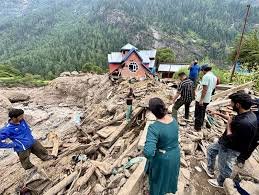Jammu, Aug 19, 2025 : The recent cloudbursts in Kishtwar and Kathua, which claimed dozens of lives, have reignited concerns over the growing clash between developmental activities and the fragile Himalayan environment.
From landslides and subsidence in Doda and Ramban to flash floods triggered by cloudbursts in Kishtwar and Kathua, experts warn that many disasters are aggravated by large-scale projects in ecologically sensitive zones. The construction of roads, tunnels, and hydro-power projects has transformed Jammu’s landscape but also heightened vulnerability in mountain ecosystems.
On August 14, more than 60 people were killed in Kishtwar when a cloudburst triggered flash floods at a community kitchen site along a seasonal nullah. Days later, a cloudburst in Kathua swept away homes in forested areas, leaving seven dead. Visiting Kishtwar, Chief Minister Omar Abdullah admitted that J&K, Himachal Pradesh, and Uttarakhand are witnessing an alarming rise in extreme weather events, calling for expert-driven mitigation strategies.
The risks are not limited to cloudbursts. Glacial lake outburst floods (GLOFs) are emerging as a new threat, driven by accelerated glacier melt linked to climate change. Earlier this year, surveys of Mundiksar, Hangu, and another glacial lake in Kishtwar highlighted potential hazards if containment strategies are not adopted.
Yet, for local communities, development remains a lifeline. Remote areas of Jammu have long suffered from poor connectivity, limited healthcare, and scarce job opportunities. Roads and hydro projects promise employment and access, making the development-versus-ecology debate particularly complex.
Climate change is already reshaping the region, with erratic rainfall, rising temperatures, and deforestation further destabilising the Himalayan belt. M.Y. Tarigami, Chairman of the J&K Assembly’s Environment Committee, has called for a mass movement against unchecked deforestation and unsustainable construction, urging government departments, activists, and NGOs to coordinate climate adaptation strategies.
The way forward, experts stress, is not to halt development but to redefine it—focusing on sustainable models with regulated construction, scientific road alignment, controlled deforestation, and stronger disaster preparedness. Only then can Jammu balance the imperatives of progress with the realities of its fragile ecology.



















